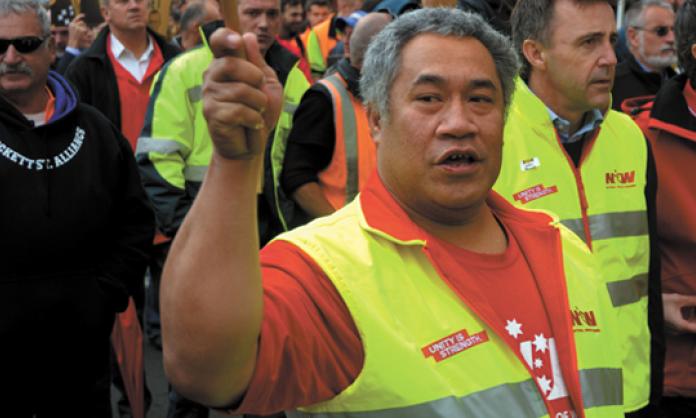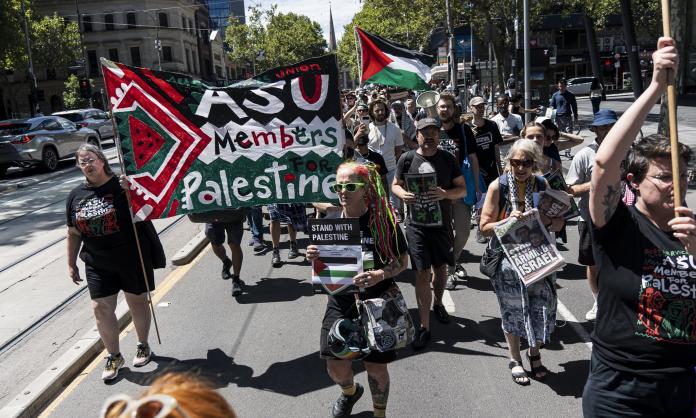The maths are pretty clear. If we keep losing members at the current rate, the Australian union movement will finish up entirely in late March 2026.
According to the Australian Bureau of Statistics, in August of last year 1,747,600 workers in Australia were union members in our main job. By August this year, the number had slumped to 1,596,700. Losing more than 150,000 members per year means extinction in just over a decade.
At that point, the organisations that won the world’s first eight-hour working day, that won decent wages for generations, that gave crucial industrial and political strength to struggles against war, racism and environmental destruction, would cease to exist.
Of course, this mass extinction is far from inevitable. Apart from anything else, many thousands of us will fight like hell to make sure that our unions stay around as fighting organisations of the working class.
The crucial question is: what approach will serve us best in that task?
Step one is to acknowledge the dimensions of the problem. Here the peak union body, the Australian Council of Trade Unions, totally fails – denying there is any great crisis to deal with.
We should be clear that not only are membership levels, but also strike rates, bumping along at near record lows. Many union structures are little more than hollowed-out shells, propped up by institutional support or sweetheart deals rather than member participation and control.
Step two is to identify the causes of the problem. A couple of common arguments are worth knocking over here.
First, and most obviously: despite automation, relocation and social changes, the working class has the same potential power that we’ve always had. We still do the vast bulk of the essential work in this society. It is our labour that makes possible every cent of profit, and this gives us a great potential power.
Of course, the working class has changed a lot. Throughout its history, capital has continuously restructured production and thus the working class too. There are always some sections of the working class being squeezed, while other sections experience rapid growth.
But there’s nothing in these changes that has made workers impossible to organise or hostile to unions. A recent Essential Media poll showed that nearly two-thirds of people agree that unions are important, while around half agree that workers would be better off if unions were stronger.
In non-union workplaces, polling shows a significant minority – 18 percent in a 2010 survey – say they would join a union if they were asked. When unions bother to ask members why they left, the overwhelming reason given is not some anti-union perspective, but simply a change of jobs.
All this points to the source of the problem being, not the workers of today, but our unions’ approach to organising.
This leads to a variety of possible solutions being canvassed. Some initiatives target young workers, while other efforts go into creating broader categories of membership, or a greater engagement on particular social issues.
Some of these initiatives are pitched as being part of the union movement’s “imperative to innovate”, as ACTU president Ged Kearney recently wrote in the Guardian. Fundamentally, though, the innovation we need is a return to the basics. It’s isn’t hard to work out. It doesn’t require new thinking.
Only a concerted campaign of organising in our workplaces can start to address the crisis of membership. Such an organising drive would be one vital element of any serious strategy for rebuilding union power.
And there would need to be serious hard work to cut against sectional and other divisions and foster active solidarity between workers across the various arbitrary divisions imposed on us (including by shifts, employment categories, workplaces, industries and national borders).
Other elements of a strategy to turn the unions around would be to organise seriously for mass defiance of Australia’s ever more restrictive anti-union laws, instead of unending compliance – and, often, de facto enforcement of them.
Crucially though, a successful strategy would be based on class struggle rather than class collaboration – which has been the hallmark of Australian unionism since at least the time of the disastrous Prices and Incomes Accord of the 1980s.
Some union leaders now tut-tut about the Accord and the collapse in workplace organisation it brought about, as union leaders enforced industrial peace in return for Labor’s promised expansion of the “social wage” that never arrived. But the underlying strategy of class collaboration expressed in the Accord has not been seriously challenged in the trade union movement in the three decades since.
Today, many union offices are never so alive with activity as when they’re organising a doorknocking or calling campaign to get Labor elected. As a strategy to rebuild power in the workplace, however, election-focused doorknocking in the highly dispersed suburbs of Australia points us in totally the wrong direction.
No one pretends that Labor in power would fundamentally turn around the long term decline of unions in Australia. Unions hope, at best, for a slight easing of the relentless pressure under a Labor government (and even this seems like a shaky prospect, as an insipid Shorten signs on to gifts to big business like the China-Australia Free Trade Agreement).
Almost all the prescriptions given for a sustained union revival miss one crucial ingredient: radical politics.
In the history of the workers’ movement in Australia, there have been three great union revivals. Each one of these turning points has been closely bound up with a revival in radical, anti-capitalist politics in significant sections of the working class.
When unions recovered from the brutal defeats of the 1890s, a major role was played by the revolutionary socialists and syndicalists of the Industrial Workers of the World, the Victorian Socialist Party and similar organisations.
When unions broke through in the middle and late 1930s, after suffering colossal defeats as the Great Depression hit, members of the Communist Party and those around them played a disproportionate role.
After a sharp upturn in strikes after World War Two, the union movement was shackled by the anti-union “penal powers” laws until the late 1960s. Eventually, the penal powers were smashed by the rolling, nationwide general strike in 1969 that freed the communist leader of Melbourne’s tramways union, Clarrie O’Shea.
This massive upsurge in struggle was fed by the widely based radicalisation against the Vietnam War, and was reflected in a variety of socialist organisations. Students who radicalised on the campuses in this period went on to be part of important struggles in various white collar workplaces, such as banks and schools, with little previous history of militant union struggle.
The political tendencies that contributed to these upsurges had very significant limitations. But at their best, they helped shape the political world view of generations of worker militants and helped connect militants across industries and further afield.
For individual militants, developing power in the workplace today can be a hard, unglamorous slog. If we’re not pointing towards serious industrial action, we’re pointing in the wrong direction. But in most workplaces it will be a series of very small concrete steps that set us off in that direction.
It might be workers accompanying a fellow worker to a disciplinary hearing. It might be circulating an open letter, writing a leaflet with a few workmates or taking a workmate to a picket or protest.
In some highly atomised workplaces, we have to start even further back: introducing any sort of opportunity for collective discussion – like a regular “cake day” or barbecue – can be crucial in opening up opportunities for discussions about workplace issues. These small steps can lay (and in many cases have laid) the basis for larger organising projects.
Whatever small steps we can take to discuss politics at work are vital. Workers can be ground down by daily life and years of union retreat. The idea of having a union strong enough to put the boss in their place can seem like a pipe dream. So general left wing and socialist politics can at least cohere one or two people on a good basis, and lay the basis for further activity.
And in the long term, of course, being political in the workplace is essential to building up a socialist political alternative – an alternative to capitalism and its hideous priorities, and an alternative to the miserable politics of defeat and retreat that has led the union movement into this situation. Building such an alternative is an indispensable part of reviving workers’ struggle and turning our organisations around.











